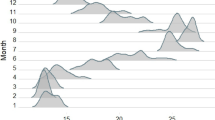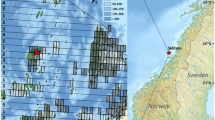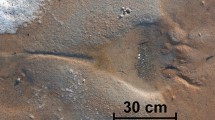Abstract
Here we report the first observations of the rapa whelk Rapana venosa massively bio-fouling immature green turtles Chelonia mydas. From November 2004 to July 2011, we examined 33 green turtles with rapa whelks attached to their carapaces in Uruguayan waters. The number of attached rapa whelks ranged from 1 to 49 individuals, representing up to 20 % of turtle weight. This previously unrecorded interaction may be of global importance to green turtles conservation because (a) immature green turtles from distant breeding populations utilize insular and coastal waters of the Río de la Plata estuary and Atlantic coast of Uruguay as developmental and foraging habitats and (b) attached whelks may reduce green turtle fitness by reducing buoyancy, increasing drag, and causing severe injuries to the carapace.
Similar content being viewed by others
Avoid common mistakes on your manuscript.
Introduction
The green turtle (Chelonia mydas) is an endangered species (Seminoff 2004) distributed worldwide, inhabiting continental shelves, bays, lagoons, and estuaries in the temperate, subtropical and tropical waters of the Atlantic, Pacific, and Indian Oceans (Hirth 1997). In the Southwestern Atlantic (SWA) adult green turtles nest in the oceanic islands of Trindade, Atol das Rocas, and Fernando de Noronha, and less frequently in the northern coast of Bahia, Brazil, while juvenile green turtles occur in neritic waters along the continent and oceanic islands (Marcovaldi and Marcovaldi 1999; Domingo et al. 2006).
In the Uruguayan coast, juveniles occur year round along the saline gradient defined by the confluence of freshwater discharge by the second largest South American estuary, the Río de la Plata estuary, and oceanic water masses. Important foraging and development areas for immature green turtles are located all along the coast, including oceanic (e.g. Cerro Verde, Punta del Diablo and Valizas-Cabo Polonio) and estuarine sites, e.g. Bajos del Solís ((López-Mendilaharsu et al. 2003; López-Mendilaharsu et al. 2006). Inmature green turtles occurring along those areas recruit to adult populations nesting mainly in Ascension Island (UK) but also in Trinidad (Brazil), Isla de Aves (Venezuela), Surinam and Guinea Bissau, Africa (Caraccio 2008). As such, ecological phenomena affecting green turtles occurring in Uruguay can be of global significance for green turtle conservation.
Rapana venosa (Valenciennes, 1846), a large, predatory gastropod and one of the most conspicuous invading mollusks, was introduced during the 90 s in the Río de la Plata Estuary (Scarabino et al. 1999; Pastorino et al. 2000). This species has been shown to be widespread in the area, reaching very high densities all along the Río de la Plata estuary, both in hard and soft bottoms (Scarabino et al. 2006; Giberto et al. 2006; Lafranconi et al. 2009; Carranza et al. 2010), and is a threat to native bivalves (e.g. the blue mussel Mytilus edulis; Carranza et al. 2010; Scarabino et al. 1999). However, the rapa whelks also constitute an important dietary item for immature loggerheads (Caretta caretta) in the Río de la Plata estuary (Carranza et al. 2011). Recently, Harding et al. (2011) reported the first record of R. venosa as an epibiont of loggerheads in the South Atlantic Bight, USA, suggesting that sea turtles can be potential dispersal vectors. All this evidence reinforces the idea that interactions amongst invading and native species are often hard to predict (Walther et al. 2002).
To date, there are no reported interactions between green turtles and the rapa whelk. Thus, the objectives of this paper are to (1) report the first observations of the rapa whelk bio-fouling immature green turtles Chelonia mydas in Uruguayan waters and (2) test the hypothesis that this interaction negatively affects the fitness of green turtles.
Materials and methods
Bio-fouling of rapa whelks was examined opportunistically from 33 green turtles captured or stranded in the Uruguayan coast (Fig. 1) between November 2004 to July 2011. All turtles were measured in Curved Carapace Length (CCL) and weighted to the nearest 0.5 kg. Initially, when present, 155 attached rapa whelks (Fig. 2) were only removed and counted. Later, systematically, 94 whelks were also weighed by a local fisherman when a colonized turtle was captured or found stranded. Using the mean individual weight obtained from this sample, we estimated the expected total weight of attached whelks in the remaining turtles and calculated, in terms of percentage of turtle weight, the extra load the whelk bio-fouling represented.
Map of the Río de la Plata estuary, indicating main locations of collection of green turtles with attached rapa whelks 1: San José de Carrasco; 2: Arroyo Pando; 3: La Floresta—San Luís; 4: Araminda—Isla de La Tuna; 5: Bajos del Solís; 6: Playa Verde—Piriápolis; 7: Punta del Este. Known records of Rapana venosa are also indicated (green circles), as well as a coarse characterization of sediment type. (Color figure online)
To test hypothesis (2), we used weight at CCL as a proxy of turtle fitness. To this end, we performed an ANCOVA to detect differences in green turtle weight among bio-fouled and “clean” individuals using CCL as a covariate, after checking ANCOVA assumptions. As the “control” group, we used green turtles (n = 98) from the same area that were measured and weighted during Karumbé (an Uruguayan NGO working in sea turtles conservation) usual monitoring activities. In addition, for colonized turtles, a regression analysis was made between number of whelks and the ratio between individual weight: CCL, the latter used as a proxy of turtle condition.
Results
Thirty-three turtles were found with attached whelks from November 2004 to July 2011; 17 (52 %) were found stranded and 16 (48 %) were incidentally captured. Six turtles (18 %) were found dead and 27 (82 %) were still alive when measured, most of them with severe injuries on their carapaces caused by these gastropods. Bio-fouled green turtles averaged 42.02 cm of CCL, ranging from 34 to 62 cm. Attached rapa whelks ranged from 1 to 49 individuals, averaging 8 ± 9.91 (SD) individuals per turtle. Mean size of rapa whelks was 70.59 ± 5.95 mm, weighing in average 80.21 (± 24.01) g. According to our results, attached rapa whelks may represent up to 20 % of a turtle’s weight. Neither green turtles’ CCL (p = 0.93) nor weight (p = 0.12) were correlated with the number of attached whelks. Surprisingly, we were unable to detect a negative effect of bio-fouling on turtle fitness, using length at weight as a proxy. In fact, colonized turtles showed on average a higher weight when compared with “clean” turtles collected in the same area and time period (ANCOVA; F(1, 125) = 10.791, p = 0.001). Within colonized turtles, the regression analysis evidenced a positive correlation (r2 = 0.16, p = 0.03) between both variables, indicating that number of whelks is associated with turtles condition (i.e. weight at size).
Discussion
To our knowledge, this is the first report of the rapa whelk Rapana venosa bio-fouling green turtles Chelonia mydas worldwide, and certainly the first record for the South Western Atlantic. Muricid gastropods reported so far as epibionts of sea turtles, loggerheads in particular, are species native to the southeastern US (Stramonita haemastoma flooridana Conrad [Southern Oyster Drill] and Chicoreus pomum Gmelin [Apple Murex]; Harding et al. 2011). Although many of the epibiotic species that occur on loggerheads are obligate commensals (Frick et al. 2010) this is not the case for green turtles. Most if not all epibionts also occurs in natural hard substrata, and their occurrence on green turtles appears to be largely incidental.
The study site is one of a few places along the Uruguayan coast where there is a spatial coexistence between green turtles experiencing brumation (dormancy in reptiles, similar to hibernation) and rapa whelks. The presence of rapa whelks on green turtles occurs often in winter months, and is presumably related to the brumation behavior of the turtle (Ogren and Mc Vea 1982). It seems likely that the slow-moving snails can only climb on turtle’s carapaces when they are resting in the seabed in rocky areas that are interspersed with soft bottoms in the study site. This might be related with reported habitat preferences shifts during the whelk′s ontogeny, with smaller whelks occupying hard substrates as epifauna (Harding 2003), and larger whelks spending some portion of their lives as infauna burrowed in sand or mud substrata (Bombace et al. 1994; Harding and Mann 1999). Accordingly, mean size and the shape of size frequency distributions indicate that whelks found on green turtles are smaller in shell length than those occupying other natural substrata in neighboring areas (Carranza, unpublished).
The finding of 49 rapa whelks attached to one of the turtles’ carapace, as well as the high numbers observed (mean ± SD = 8 ± 9.9), suggests a non-random association. This is also supported by the observations of carapace scars produced by the whelks. Thus, we hypothesize that (a) the turtle’s carapace is interpreted as hard substrata and/or (b) rapa whelks are attracted by turtles, or they are feeding on the epibionts living on the turtle’s carapace (B. Morton pers. com.).
Finally, the intriguing result of higher fitness of bio-fouled green turtles (measured as weight at length), when compared with “clean” turtles occurring in the same area, may be related to a better physiological condition of the former, since these turtles had already foraged in the area during summer. In contrast, the observed lower fitness of “clean” turtles may reflect the energetic costs associated to recent long-distance migration from Brazilian waters. This previously unrecorded interaction may be of global importance to green turtles conservation because immature individuals from distant breeding populations utilize insular and coastal waters of the Río de la Plata estuary and Atlantic coast of Uruguay as developmental and foraging habitats. Future work needs to examine if whelks influence green turtle fitness and if green turtles are a dispersal vector for the rapa whelks. This includes determining if: (1) whelks attached to green turtles influence their buoyancy and increase drag, (2) the extent and nature of damage to carapaces and (3) if green turtles can remove whelks and/or quantifying the amount of time whelks remain on the turtles.
References
Bombace G, Fabi G, Fiorentini L et al (1994) Analysis of the efficacy of artificial reefs located in different areas of the Adriatic Sea. Bull Mar Sci 55:559–580
Caraccio MN (2008) Análisis de la composición genética de Chelonia mydas (tortuga verde) en el área de alimentación y desarrollo de Uruguay. Tesis de Maestría del Programa de Desarrollo de las Ciencias Básicas (PEDECIBA), Área Biología- Subárea Genética. Facultad de Ciencias, Universidad de la República, p 101
Carranza A, de Mello C, Ligrone A et al (2010) Observations on the invading gastropod Rapana venosa in Punta del Este, Maldonado Bay, Uruguay. Biol Invasions 12:995–998
Carranza A, Scarabino F, Estrades A et al (2011) Loggerhead turtles Caretta caretta (Linnaeus) preying on the invading gastropod Rapana venosa (Valenciennes) in the Río de la Plata Estuary. Mar Ecol 32:142–147
Domingo A, Bugoni L, Prosdocimi L et al (2006) The impact generated by fisheries on Sea Turtles in the Southwestern Atlantic. Technical Report WWF Progama Marino para Latinoamérica y el Caribe, San José, Costa Rica, p 71
Frick MG, Zardus JD, Lazo-Wasem EA (2010) A new coronuloid barnacle subfamily, genus, and species from Cheloniid sea turtles. Bull Peabody Mus Nat Hist 51:169–177
Giberto DA, Bremec CS, Schejter L et al (2006) The invasive rapa whelk Rapana venosa (Valenciennes 1846): status and potential ecological impacts in the rio de la plata estuary, Argentina-Uruguay. J Shell Res 25:919–924
Harding JM (2003) Predation by blue crabs, Callinectes sapidus, on rapa whelks, Rapana venosa: possible natural controls for an invasive species? J Exp Mar Biol Ecol 297:161–177
Harding JM, Mann R (1999) Observations on the biology of the Veined Rapa whelk, Rapana venosa (Valenciennes, 1846) in the Chesapeake Bay. J Shellfish Res 18:9–17
Harding JM, Walton WJ, Trapani CM et al (2011) Sea turtles as potential dispersal vectors for non-indigenous species: the veined rapa whelk as an epibiont of loggerhead sea turtles. Southeastern Nat 10:24–233
Hirth HF (1997) Synopsis of the biological data on the green turtle, Chelonia mydas (Linnaeus 1758). United States fish and wildlife service biological report 97–1, p 120
Lafranconi A, Hutton M, Brugnoli E et al (2009) New record of the alien mollusc Rapana venosa (Valenciennes 1846) in the Uruguayan coastal zone of Río de la Plata. Pan Am J Aq Sci 4:216–221
López-Mendilaharsu M, Fallabrino A, Bauza A et al (2003) Review and Conservation of Sea Turtles in Uruguay: foraging habitats, distribution, causes of mortality, education and regional integration. Final report: British Petroleum Conservation Programme, p 109
López-Mendilaharsu M, Estrades A, Caraccio M et al (2006) Biología y ecología de las tortugas marinas en la zona costera uruguaya. In: Menafra R, Rodríguez-Gallego L, Scarabino F, Conde D (eds) Bases para la Conservación y el Manejo de la Costa Uruguaya. VIDA SILVESTRE Montevideo, Uruguay, pp 247–258
Marcovaldi M, Marcovaldi G (1999) Marine turtles of Brazil: the history and structure of Projeto TAMAR-IBAMA. Biol Cons 91:35–41
Ogren L, Mc Vea J (1982) Apparent hibernation by sea turtles in North American waters. In: Bjorndal KA (ed) Biology and conservation of Sea Turtles. Smithsonian Institution Press, Washington, pp 127–132
Pastorino G, Penchaszadeh PE, Schejter L et al (2000) Rapana venosa (Valenciennes, 1846) (Mollusca: Muricidae): a new gastropod in south Atlantic waters. J Shellfish Res 19:897–899
Scarabino F, Menafra R, Etchegaray P (1999) Presencia de Rapana venosa (Valenciennes, 1846) (Gastropoda: Muricidae) en el Río de la Plata. Bol Soc Zool Uruguay (Actas de las V Jornadas de Zoología del Uruguay) 11 (Segunda Epoca)
Scarabino F, Zaffaroni JC, Carranza A et al (2006) Gasterópodos marinos y estuarinos de la costa uruguaya: faunística, distribución, taxonomía y conservación. In: Menafra R, Rodríguez-Gallego L, Scarabino F, Conde D (eds) Bases para la conservación y el manejo de la costa uruguaya. VIDA SILVESTRE (Sociedad Uruguaya para la Conservación de la Naturaleza) Montevideo, Uruguay, pp 143–155
Seminoff J (2004) Global status assessment green turtle (Chelonia mydas). Marine Turtle Specialist Groups. The World Conservation Union IUCN. www.iucn.org p 34
Walther G-R, Post E, Convey P et al (2002) Ecological responses to recent climate change. Nature 416:389–395
Acknowledgments
We would like to thanks to Coco Meirana and Alfredo Hargain for their kind collaboration with the collection of turtles. B. Morton is acknowledged for providing insights on the causes of this interaction, as well as the editors and two anonymous referees that helped to improve the manuscript. Financial support from BP Conservation Programme and IFAW to Karumbé members and Agencia Nacional de Investigación e Innovación (ANII) and Rufford Small Grants for Nature Conservation to AC is acknowledged.
Author information
Authors and Affiliations
Corresponding author
Rights and permissions
About this article
Cite this article
Lezama, C., Carranza, A., Fallabrino, A. et al. Unintended backpackers: bio-fouling of the invasive gastropod Rapana venosa on the green turtle Chelonia mydas in the Río de la Plata Estuary, Uruguay. Biol Invasions 15, 483–487 (2013). https://doi.org/10.1007/s10530-012-0307-9
Received:
Accepted:
Published:
Issue Date:
DOI: https://doi.org/10.1007/s10530-012-0307-9






